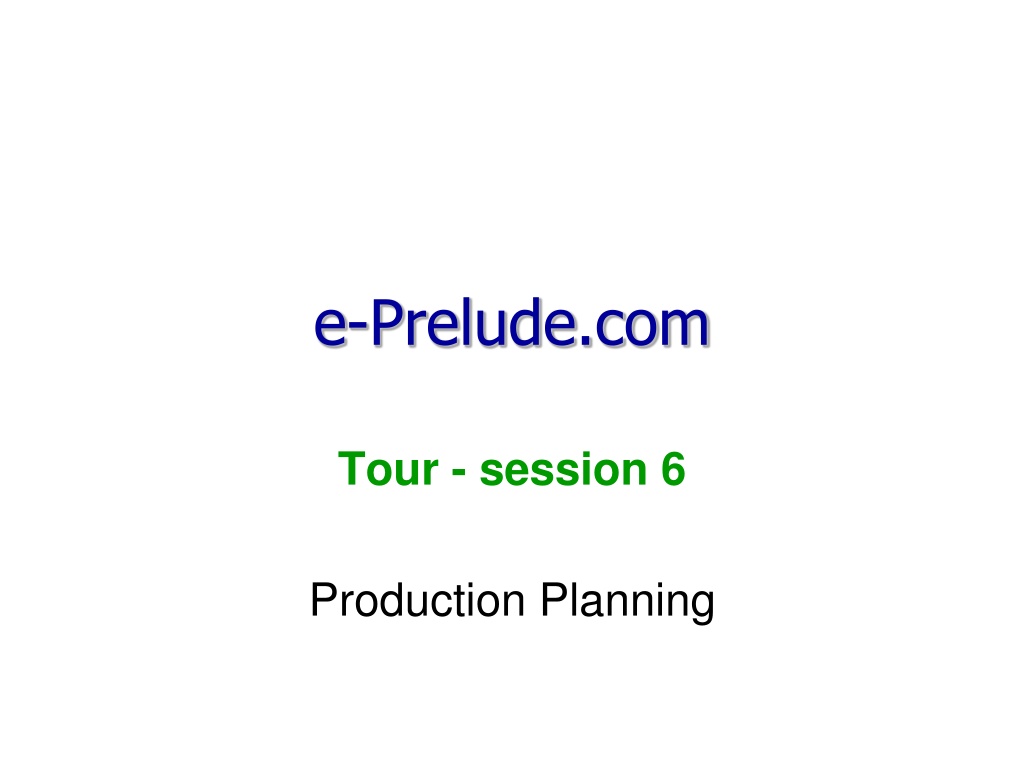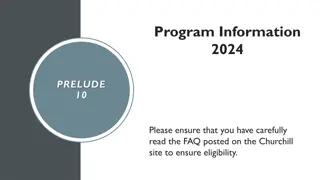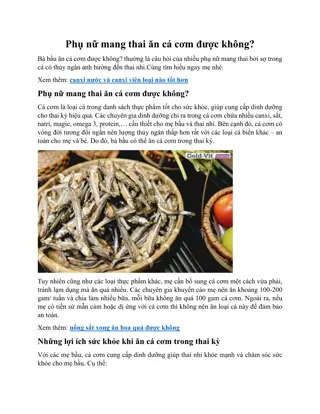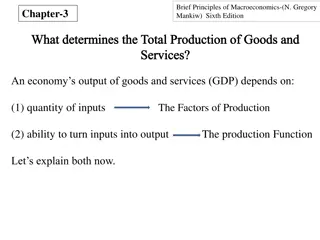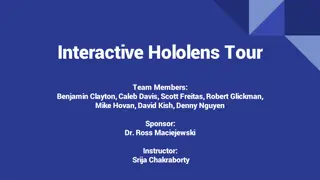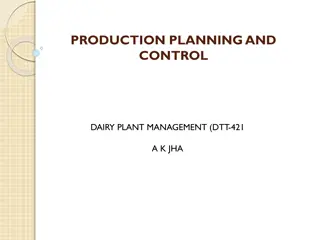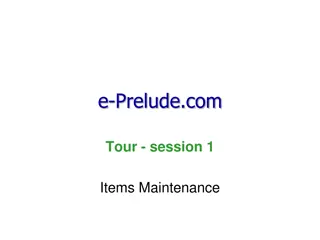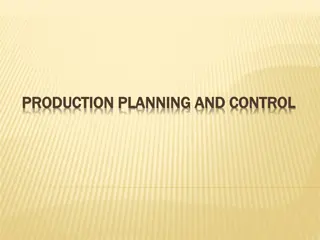Production Planning in e-Prelude.com Tour: Session 6 Overview
This session focuses on production planning in the context of e-Prelude.com Tour, emphasizing the purpose, demand, calculations, MRP principle, and gross requirements in the manufacturing process. It covers areas like satisfying customer orders, managing inventory levels, calculating quantities, and understanding the Materials Requirements Planning (MRP) principle in detail.
Download Presentation

Please find below an Image/Link to download the presentation.
The content on the website is provided AS IS for your information and personal use only. It may not be sold, licensed, or shared on other websites without obtaining consent from the author. Download presentation by click this link. If you encounter any issues during the download, it is possible that the publisher has removed the file from their server.
E N D
Presentation Transcript
e-Prelude.com Tour - session 6 Production Planning
Production Planning Purpose Satisfy customer orders Place purchase orders to vendors Insure a high capacity utilization Aim to a minimum inventory level Provide a work plan to the workshops 2
Finished good Demand The planning process starts from Sales orders Firm orders Shipment schedules Sales forecast Made by the manufacturer Inventory look up For items made to stock if the on-hand quantity is lower than the order point 3
Calculation of quantities to make and to source General principle: Materials Requirements Planning (MRP) Alternate method: Managing inventories 4
MRP Principle It starts with end-items (level 0) to generate quantities of immediate components (level 1) using the BOM. These are called gross requirements By taking into account the existing inventories, it computes the net requirements at this level = Gross requirements Inventory on hand + Inventory desired level (safety stock) Future requirements are eventually regrouped (lot sizing) Similarly, all other levels are analyzed To position the requirements in time, it takes into account the production/procurement lead times of the items 5
Gross Requirements = Orders/Forecasts Level 0 : Finished goods FG Inventory and assembly WIP Finished Good Assembly Orders Finished Good Net Requirements Finished Good BOM Level 1 : Sub-assemblies Sub-assembly Gross Requirements Sub-assembly inventory and manufacturing WIP Sub-assembly Manufacturing Orders Sub-assembly net requirements Sub-assembly BOM Level 2 : Parts Part Gross Requirements Part Inventory and fabrication WIP Part Part Fabrication orders Net Requirements Level 3 : Materials Part BOM Material Gross Requirements Material Inventory and open purchase orders Purchase orders Material Net Requirements 6
Taking into account the production lead time Parent Item Release Date Parent Item Requirement Date Manufacturing Lead Time Date of component requirements To determine the release dates (for the parts to be produced) and those of the purchase orders (for the parts to be purchased), one must take into account the lead time required to obtain the parts (expressed in days). For purchased parts, the lead time is the Delivery Lead Time of the supplier For the parts produced internally, it is the time required to complete all the production stages of a batch of products. This time is defined in the routings. 7
Taking into account the procurement lead time (for purchased items) Material Date of purchasing order issue requirement date Procurement lead time Specifies in days on the item Reorder Policy page 8
Lot-Sizing Decisions MRP determines net requirements but tries to optimize orders Main Techniques: Lot for lot Economic Order Quantity (EOQ) Part Period Balancing Algorithms or heuristics Disadvantages : they increase the levels of inventories 9
Lot sizing decisions Goal: Avoid creating too many work or requisition orders in a short period of time Thus reduce the number of production orders releases or purchase orders which generate fixes costs (clerical work, changeover time, transportation, ) but... creation of inventory (because a requirement is anticipated) 10
Item Management Parameters Access: Planning menu, Item Reorder Policy option 4- Validate 1 - Select the Reorder policy 2 - Select the lot sizing rule 3- Specify the production lead time 11
A production process Material X Sub-assembly SA 1 Part A Finished good Sub-assembly SA 2 Material Y Part B Sub-assembly SA 3 Routing Routing Routing 12
Production planning steps Requirements Manufactured items Purchased items MRP calculation Planned requisition orders Planned Work Orders Conversion Conversion Firm requisition orders Firm Work Orders Order release Purchase order entry Open Work Orders Purchase Orders Execution Receipt Closed Work Orders Closed Purchase Orders 13
Successive Work Order status Planned WO Firm WO Open WO Closed WO 14
Work order status depending on the time horizon Current date Closed WO Open WO Firm WO Planned WO time WO Release end date WO Conversion end date MRP Calculation end date 15
A calendar The plant calendar defines working days Requirements offsets are calculated on working days Example: There is a requirement for item A with a lead time of 6 days for Wednesday of week 3 The release date is calculated by moving backward on the calendar of the number of days of the lead time Release Requirement 6 days Mo Tu We Th Fr Sa Su Mo Tu We Th Fr Sa Su Mo Tu We Th Fr Sa Su Week 1 Week 2 Week 3 16
Materials Requirements Planning Access: Planning menu, Material Requirements Planning option Specify a calculation end date to avoid generating orders for far demands Items are processed by increasing level order 17
Planned Work Order List Access: Planning menu, Planned Work Order List option 18
The Planned Work Order window Access: Planning menu, Planned Work Order Maintenance option 19
Item Master Schedule Access: Planning menu, Master Schedules option Planned orders appear in the Master Schedule Inventory Profile is updated 20
Scheduling and capacity utilization WO are scheduled using infinite capacity loading One after the previous without taking into account the number of available machines on the work center Operations are placed with times calculated from the routings on work center time slots (calendar) forward (starting from the release date) backward (starting from the due date) Work loads are cumulated on each time slot 21
Work center schedules Using the calendar, determination of working time slots for each work center 8h 8h 8h 8h 8h WC 1 Mo 8:00 Tu 8:00 We 8:00 Th 8:00 Fr 8:00 8h 8h 8h 8h 8h WC 2 22
Scheduling of a Work Order Example Release date: Monday Due date: Friday (must be finished on Thursday night) Operation 010 on WC 1, duration 10 hours (setup time + run time) + 3 hours for transfer Operation 020 on WC 2, duration 12 hours (setup time + run time) + 3 hours for transfer 23
Forward scheduling Release date Due date 8h 8h 8h 8h 8h WC 1 Mo 8:00 Tu 8:00 We 8:00 Th 8:00 Fr 8:00 8h 8h 8h 8h 8h WC 2 Op. 010 3h 10h Op. 020 3h 12h Slack: 4h Earliest end date 24
Backward scheduling Release date Due date 8h 8h 8h 8h 8h WC 1 Mo 8:00 Tu 8:00 We 8:00 Th 8:00 Fr 8:00 8h 8h 8h 8h 8h WC 2 Op. 010 3h 10h Op. 020 Latest start date 3h 12h Slack: 4h 25
Infinite Capacity Scheduling Access: Planning menu, Infinite Capacity Scheduling option Specify a calculation end date to avoid useless calculations 26
Infinite Capacity Scheduling Chart Access: Planning menu, Scheduling Chart option 27
Infinite Capacity Schedule Dates Access: Planning menu, Planned Work Order Maintenance option Scheduling dates are calculated 28
Work Order Slack Analysis Access: Planning menu, Planned Work Order Slacks option 29
Capacity Utilization On each time slot, work loads originating from WO are cumulated For Forward and Backward schedules 8h 8h 8h 8h 8h WC 1 Mo 8:00 Tu 8:00 We 8:00 Th 8:00 Fr 8:00 4h 6h WO 1 4h 8h WO 2 2h 2h 8h 5h WO 3 4h 12h 16h 7h Work Load 30
Work Load Table Access: Planning menu, Scheduling Chart option 31
Work Capacity Utilization Summary Access: Planning menu, Resource Capacity Utilization Summary option 32
Workload Chart Access: Planning menu, Workload Chart option 33
